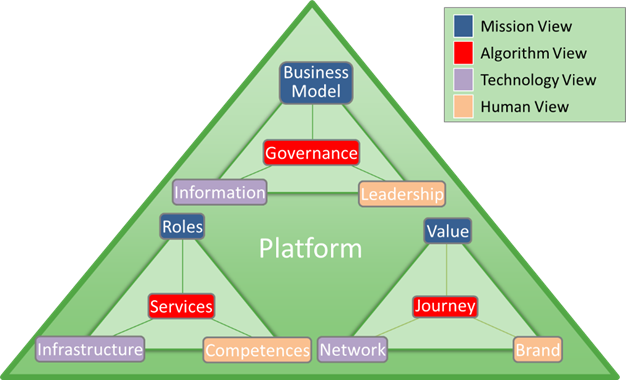
Summary
| This chapter is a thorough description on the Perspectives, Themes, Approaches and Views of the Platform
Dimension. The Platform Dimension is the cornerstone of the 4Dimensions™ Transformation Framework. When telling |
What is a Business Platform?
The narrow definition of the Business Platform is
| The collection of Assets needed for the business to fulfil its mission |
However, in the globalised and digitised world the Business Platform must also fulfil additional requirements.
- The Business Platform must be fast and easy to change. It must be easy and cheap to reshuffle the value chain by swapping modules in and out. It will be necessary to have a standardised, Lego-block-like business architecture so that modules can be added, removed or replaced.
- The Business Platform should be highly scalable. In the digitised world with many price comparison portals it will be important to reach operational efficiency fast, to break in to a market. And with a global demand there may be large fluctuations in demand.
- The Business Platform must be easy to integrate with its customers. It should be able to hold, share and use customer generated content. The more content the business share with its network, the higher the value of the platform.
The Platform Dimension connects into the strategy through the organisations mission. The mission is detailed by the organisations business algorithm. The algorithm tells how the organisation is going to function. The work in the organisation can be done by either technology and humans. This represents the business platform.
The 3 Perspectives of the Platform Dimension
The business platform is intended to repetitively and efficiently produce and deliver value to the customer. The delivery organization will continue running the business as usual. It consists of 3 perspectives.
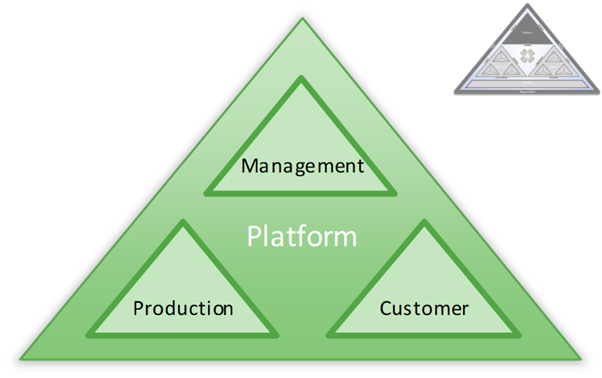
Management Perspective
The Management Perspective ensures the management of the business model, performance and process optimisation. It is the big-picture view of the various functions and work as the coordinator and enabler for these various functions.
Customer Perspective
The Customer Perspective handles value exchange and market development with the outside world. It deals with the external stakeholders and forges a relationship with them by communicating and positioning the services.
Production Perspective
The Production Perspective produces the organization’s output. This is the product or the service that offers the solution for client’s needs.
12 Themes of the Platform Dimension
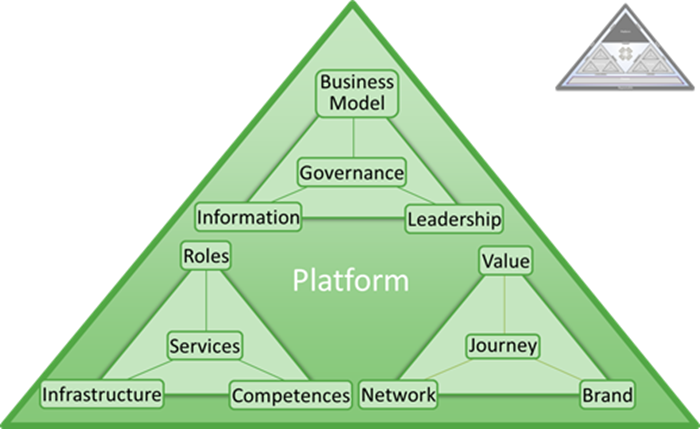
Background for the Platform Themes
Over the last few decades, several methodologies for business analysis have been developed. Some of the most well-known are the McKinsey 7S model, Leavitt’s Organizational Change Model, McCarthy’s 4P model, W. Chen’s Blue Ocean Strategy and Robert Kaplan’s Balanced Scorecard. However, most of these are based on a 1980’s mindset and need an adjustment to a digitised, globalised world’s mindset. These models were not created with the modern technology-driven businesses in mind.
The objective of the Platform Dimension is to create common ground that will let the Transformation Organisation concurrently use the existing and well-proven model frameworks and ensure that there is a common interface between the models. It attempts to develop a common framework from which all the relevant and beneficial elements from each of these methodologies can be extracted and utilised, while those that are redundant or outdated are discarded.
The Customer Perspective
The Customer Perspective is inspired by McCarthy’s 4P Marketing Model. However, that model still operates inside-out by taking starting point in the product and not in the customers need. When working with this perspective, it is very important to take an outside-in approach. Try to see things from a customer perspective!
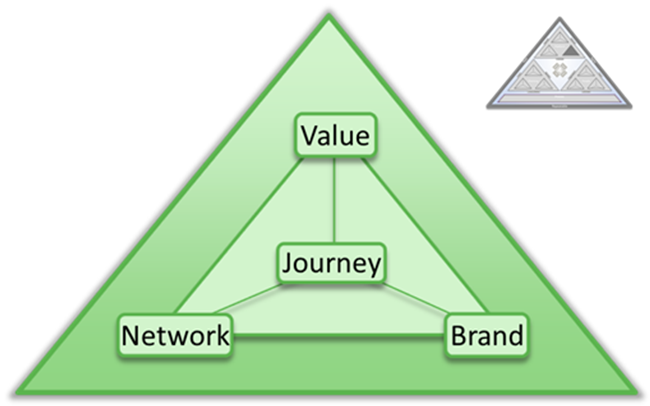
Customer Value Theme
The Customer Value Theme is directly derived from the Business Mission. Value is a very broad definition and the value delivered by the business may be perceived very different from individual to individual. Some customers may like a service – some may not. In this Theme the value for the customer is described in very specific details.
| The customer value is the benefits for which the customer is willing to provide an effort or pay for to obtain. |
Customer Journey Theme
The Customer Journey is concerned with all the touch points where the business interacts with the customer. However, the customer can be very abstract. In organizational buying, there can be several people and roles involved in the buying process. Also, when selling to individuals, the individual may be influenced by several people in their family, friends or network groups.
The Customer Journey Theme includes mapping out the entire customer life cycle, along with all the Touch Points between the customer and the company.
The customer journey is split into the actions and occurrences happening before, under and after the customer has realised the value.
| The customer journey is the sequence of touch points in the customer life cycle in which the customer value is delivered.A touch point is the distinct situation where a customer interacts with the business’s services or the value chain. |
An effective way to describe how value is delivered to the customer (or partner) is through a user story. The value proposition can be detailed by working with different customer profiles and customer segments.
| A user story is one or more sentences in the everyday or business language of the customer or end user that captures what a user does or needs to do as part of his or her job function. It captures the ‘who’, ‘what’ and ‘why’ of a requirement in a simple and concise way. |
Network Theme
There is no denying that the Internet and social media have permanently disrupted the way we communicate. Information is only a click away, and can be accessed anytime, anywhere and on any device. Customers have multiple information channels where they can exchange opinions and experience outside the business’s control. The information flow is unstructured and unpredictable. From a marketing perspective, this is a nightmare.
| A Network is a facility for moving information (ex. via social media) and services between parties (ex. logistics) |
A network has characteristics of gravity; the more people engaging in a network, the more attractive the network becomes to outsiders. The size is directly correlated with the amount of information within the network and the potential and relevance for different services. From a producer’s perspective, having access to a large network often leads to lower unit cost (for digital services it may even converge to zero), however, as more producers access the network and competition increases, the potential profit within the network declines for that specific service (and may converge to zero given the unit cost).
The Network Theme relates to this paradigm, namely how the company can maximize value through touch points by building and strengthening relationships through:
- Information and data
- Integrated processes
- Aligned strategies
- Co-sourcing
- Optimized value chain
- Logistics
Brand (Perception) Theme
From a marketer’s perspective, positioning the business in relation competition and communicating the value of the product and service is crucial. It describes how customers should perceive the value that the business delivers in the touch points.
| The customers Brand (perception) is the customer/user perception of the value delivered by the business. |
Brands help customers in a crowded marketplace more rapidly distinguishing the difference in the value of a product or service from different suppliers. Brands are very often constructed like personas to whom the customers can relate.
The Management Perspective
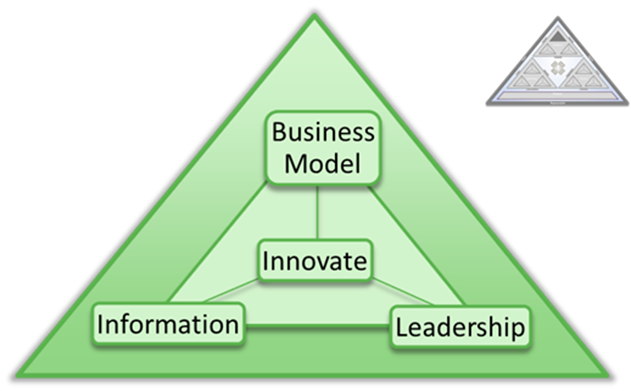
The management part describes how the management controls the business. The perspective synchronizes the Customer Perspective with the Production/Service Perspective. It ensures profitability of the business by balancing the costs of production/service and the income from delivering value to the market.
The business model must be adaptable and flexible to let the business take advantage of any opportunity that presents itself. The subsequent Business Architecture must be agile and flexible to adapt to the changes and capitalize on the opportunities.
Capital and financial strength may be a prerequisite for a business model. In this way capital is not an asset in itself, but the things you can do with the capital becomes the assets. Especially with regard to the business models you will be able to implement.
| The business model defines the distribution revenue, costs and profit in a value chain |
The business model defines how to cooperate with customers and partners in terms of creating value and minimising risks for the customer, as well as the business and its partners.
The business model is derived from the mission and the adequate value chain. It describes how the business is going to operate, create value and generate profit in the market.
Governance Theme
The Governance Theme describes how you are going to manage the business described by the business model. To manage the business, an organisation needs to be broken up into manageable units that can be controlled.
| The processes to ensure and optimise the performance of the business.
It concerns the areas · Quality and customer satisfaction management · Optimisation of Services and Customer Journey · Cost and profit control |
Others may use the term Operating Model for this theme, where the Operating Model is an abstract representation of how an organization operates across process and technology domains to accomplish its function.
The organizational structure is a part of the Governance Model. The structure defines which individual is responsible for which roles in the organization. The organizational structure may change frequently, whereas the generic roles relation to the organisation’s services will not change unless the services change.
In the digital economy, customer generated content is one of the key drivers for disruption, Previously, the information was owned by the company, but in a digitalized paradigm, the information is owned by the customers and users.
Companies like Uber, Airbnb and Facebook only provide the infrastructure where that data can be used to achieve desired results. Interaction with customers can generate enormous amount of data. The Big Data concepts resides in this theme. Customer generated data is one of the most valuable assets in the digital economy.
| Information is data generated by the customers or the business itself to be used for interaction with the customers and/or optimize the business. |
Internally the key component of the Information Theme is the Information model. The model represents the semantic understanding of the business. It is the mutual vocabulary and data model for the business. As such it will let the staff exchange information with each other meaningfully.
Internal Information will fall into three categories:
- Customer information
- Management information
- Operational information
Leadership Theme
Due to the pace of change in the outside world, which is increasing rapidly, and the complexity due to globalisation, there is a growing need for more agile organisations. The old machine bureaucracy no longer works. The leadership must combine the competences of all the participants in the organisations prosses. The teams must make smarter decisions than the individuals would make by themselves. This synergy, and it helps to produce the best possible results.
| Leadership is the process of guiding and motivating staff to execute their roles |
Leadership can be described as the process of social influence in which a person can enlist the aid and support of others in the accomplishment of a common task.
Leadership is the virtual glue between governance and people. It is exercised by motivating the staff to use and extend their competence within the governance framework of the organization. To lead, a leader must find the right balance between macro and micro management.
Production Perspective
The Production Perspective describes what is happening internally in the business when it is producing goods and services. Again, it is important to maintain the holistic aspect of the Platform Dimension, as the functionality of the Production Perspective is closely connected to the influence of the two other Perspectives, the Management Perspective and the Customer Perspective.
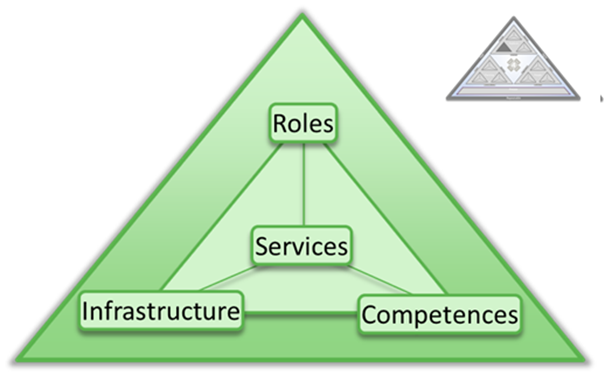
Roles Theme
The roles in the production perspective are high-level defined by the value chain and the business model. Additionally, roles can be defined by the governance process for ensuring quality and optimisation of operational efficiency.
The roles relate to producing the services. Producing a service may have to involve the work of multiple roles. A position, held by an individual, may also contain one or more roles.
Services Theme
Services are the fundamental of any business. They refer to transforming an input to an output. In doing so, the business can fulfil its mission. Services are delivered by the Customer Journeys touch points. It is up to the customer exploit value by using the services.
| A service is the work done by the business in transforming input to output. |
Services can be delivered at many levels. It can be a simple service or a complete platform that fits into a customer’s production environment or everyday life.
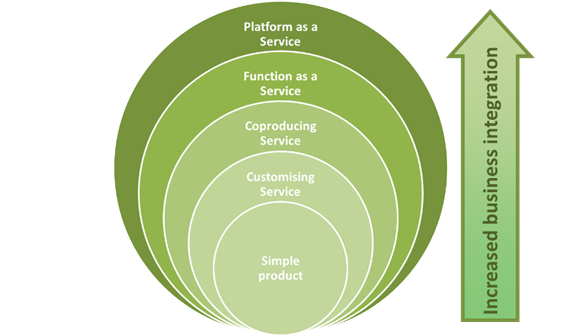
A mobile phone is a platform for apps that can be integrated into a Telco’s business platform. The apps can be used for many purposes – for example communication. Sending an e-mail is a function. The content of the message is coproduced with the user. And the e-mail can be customised in the settings. Sending an e-mail is a simple service, that may be charged separately. A cover to protect the phone is also a simple service that could be sold with the phone.
Elaborating the services hierarchy is the central part of specifying the content of a business transformation. This will be covered in more details in the process Dimension.
Infrastructure Theme
The infrastructure is the equipment that is needed for producing the services. It can be buildings, machinery, vehicles, hardware, employees or software. In many ways the infrastructure can support or substitute human work.
Infrastructure can also be a business platform of services that is provided by a partner. In this way
the infrastructure becomes a part of the business architecture, and the scalability and flexibility of the infrastructure is a key component in the agile business.
| Infrastructure are the physical Assets that can be used to produce a service. |
Competence Theme
Competences are the abilities of the individuals for producing a service by use of the infrastructure.
Competences are covered in more details in the People Dimensions, as the class of the themes in the People Dimension is Competence.
| Competence is the holistic skill set of an individual |
Views on the Platform Dimension
Many large organisations are organised in machine bureaucracies to achieve operational efficiency. This cause the organisation to operate in disconnected silos. This results in non-coherent solutions and very often, the investment will not pay off if it developed in an isolated theme. The individual components, which have been developed in isolation, very often do not integrate properly when organizations try to combine them to form a single unit. This is because they were developed in isolation, so when they are brought together, the integration fails.
Themes can be combined across Perspectives views for further analysis. The most important views are the views where the Themes hold the same position in a Perspective.
The views represent the closest relation between Themes in the other perspectives of a Dimension. Therefore, it will commonly be necessary to analyse Themes in the view together when solving challenges in one perspective.
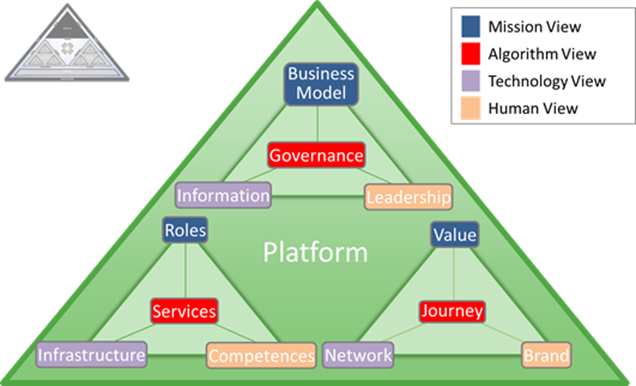
Mission View
The Mission view consists of the Themes: Customer Value, Business Model and Roles.
| The Mission View contains the structural Themes that are needed for a business to fulfil its mission. |
It is about which value the business should deliver, how the value chain should be constructed and which roles there will be in the value chain.
Algorithm View
The Algorithm View contains the Themes: Customer Journey, Governance and Services.
An algorithm is the “magic formula” that describes how the business will deliver value to the customer. Facebook, Airbnb and Uber use the 4 Drivers for Digital Transformation to create a winning algorithm, which will be difficult for others to copy. Commonly the details of the governance part of the algorithm is a trade secret. But even if a business algorithm is known, it still can be difficult to copy, because it is connected with the Platforms other Themes. Furthermore, the Network Effect may also prevent copying of an algorithm.
The Business Algorithm is the meta-structure for the groups of processes. The processes are:
- Interaction with customers
- Production of services
- Governing quality, organisational efficiency and profit
In general, the algorithm is an overlook subject in organisations. The Algorithm is owned by the Senior Management and it answers the question “Why (and how) are we going to be better than our competitors?”. But the content is implicit knowledge in the senior management and therefore difficult to share with the transformation organisation.
Technology View
The Technology view contains the Themes: Network, Information and Infrastructure.
All the Themes require equipment; either for storing or processing data when delivering services to the customer.
Human view
The Human view contains the Themes: Brand, Leadership and Competences.
It is very much a leadership task to ensure a consistent brand experience across channels. The staff needs to be educated in customer services channels and the corporate culture is commonly a part of the company’s brand and pay-off.
Using the Platform Views
The Platform Views connect directly into strategy. Having the sequence of the vision and mission, the high-level definition of mission then is explained by the algorithm for executing the mission. The algorithm can then be executed either by technology or humans or by a combination of these two.
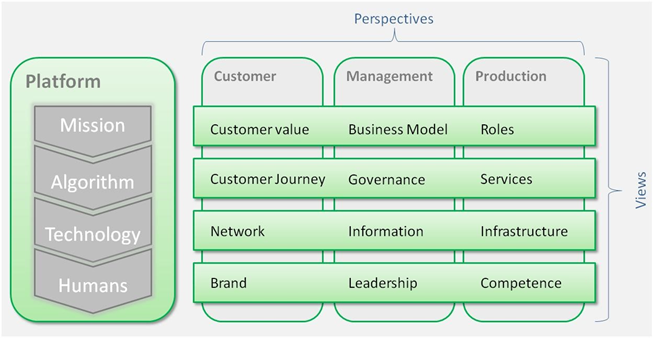
Controlling the Platform Dimension
All the themes of the Platform Dimension are Assets. In this way the value of the business is reflected by the value of all the business’s assets measured against the 3 controls:
- External Controls
- Internal Controls
- Financial Controls
The controls are also known in Kaplan and Norton’s Balanced Scorecard.
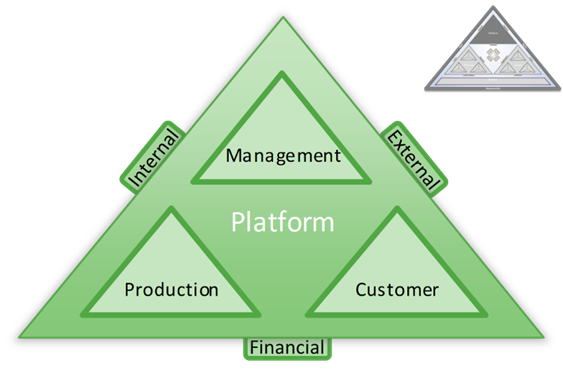
The External Controls will be related to the business’s market performance. It could mark positioning, price comparison, brand perception, customer satisfaction etc. Also, compliance with regulation is a class of controls.
The Internal Controls will be used to measure production efficiency and quality.
The Financial Controls will be data coming out of the Data Warehouse and management by Excel. Key Controls could be Return on Investment and Cost to Serve.
Approaches to the Platform Dimension
Each Approach represents a way to interact with the Platform Dimension.
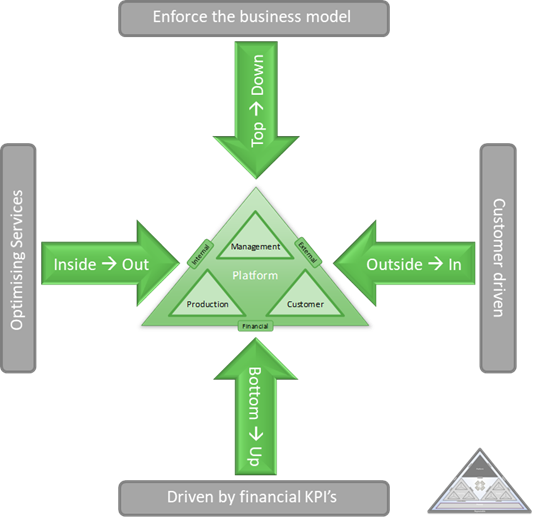
Outside-In Approach
If you want to work in a customer-centric way, the Approach will be Outside-In. Start with defining the value proposition and brand value and end with that defining the infrastructure. This mindset is known from the Design Thinking concept.
The Outside-In view starts by asking the question, “Why are we here and what value can we provide to our customers?” This will make you start with the Value and Brand Themes Outside-In Approach
Top-Down Approach
The Top-Down Approach starts with assessing the Business Model, and is followed by the Business Architecture and the rest of the themes in the Management Perspective. Then it is followed by the top themes in the external and Production Perspectives. Finally, the resulting Financial Controls will be defined (preceding the Internal and External Controls, as the Financial Controls are the outcome of the organisation’s operation). Using the top-down approach means starting with describing change using the Mission View, and subsequently using the Algorithm View. This is finally followed by the least two views. Fact finding is based on analysing the Financial Controls related to the industry and the market.
Bottom-Up Approach
The Bottom-Up Approach will let us start with the themes in the bottom of the perspectives and employ an evaluation of the Financial Controls. The Bottom-Up Approach should be based on a benchmarking study of all costs and revenue to asses a best-in-class performance in the industries from a global perspective. The Bottom-Up approach could very well take starting point in Big Data.
Inside-Out Approach
The Inside-Out Approach will start by evaluating the Production Themes and Internal Controls, followed by the Management Perspective and the Customer Perspective. The Bottom-Up Approach will focus on optimising the existing services. The focus here is related to organisational efficiency, such as an analysis of processes, fault rates and employee satisfaction.
Using different approaches
As mentioned earlier all approaches provide value when a transformation is analysed. But most the time you will not start by evaluating the business mission. It can be considered as being given. When you use the Outside-in and the Top-down approach you will need a more strategic mindset and when using an Inside-out or a Bottom-up approach, it will be an operational mindset.
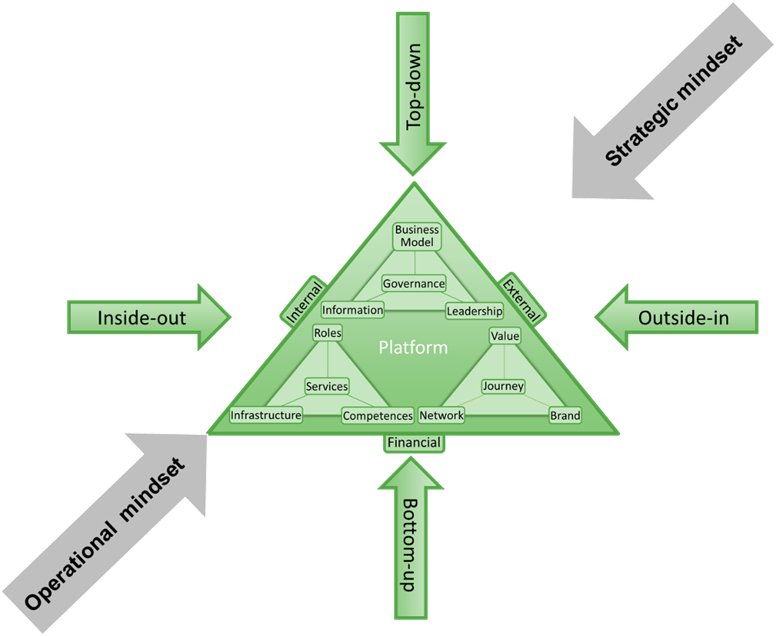
© 2018 4Dimensions.info
